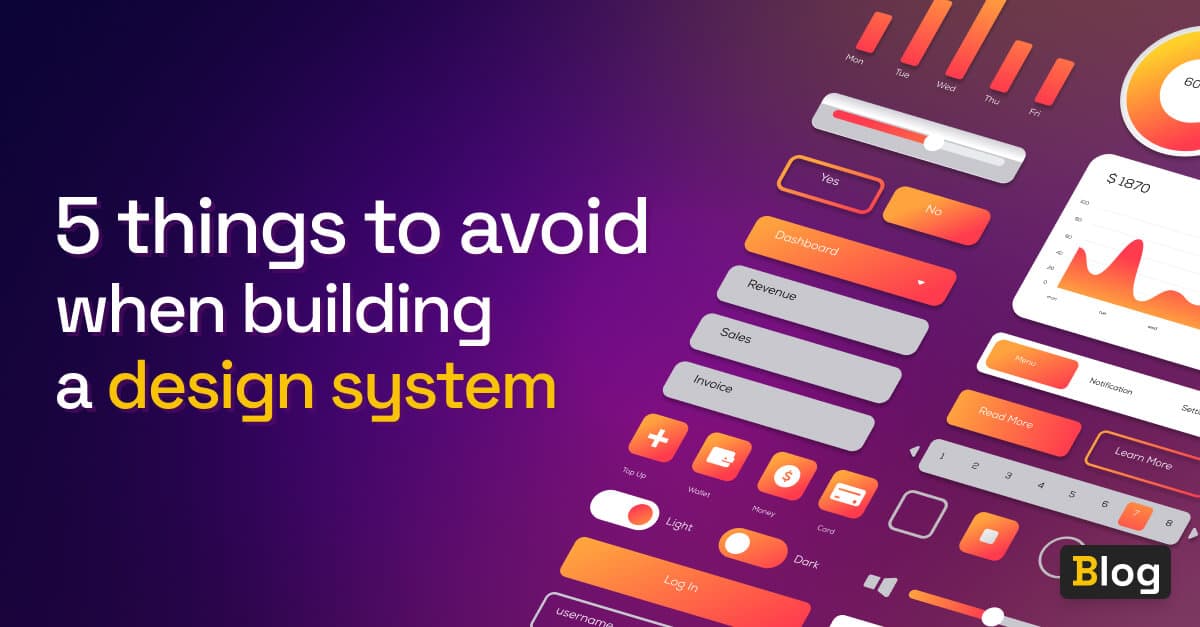
5 Things to avoid when building a design system
Many of you have probably heard about the advantages of a design system by now; they can bring huge benefits in efficiency and quality in product development. However, building a design system can be hard and sometimes involves a lengthy process that can be costly to teams in both time and resources.
Not clearly defining the value or mission of our design system, ignoring how the components interact within it, or avoiding collaboration with developers, can all lead to costly mistakes when developing a design system. Yet, these mistakes can be avoided if we pay attention to a few key points during the creation process.
In this article, we are going to look at 5 things to avoid when building a design system:
🦀 Building from scratch
Not all companies can afford to build a design system from scratch because it requires a lot of capital and resources. It is usually preferable, and more cost-efficient, to take advantage of existing solutions rather than beginning from scratch.
Choosing a ready-made solution on the market that meets your product needs can save tons of resources. Working from an existing system is less exhausting than completely reinventing the wheel. Starter kits, component libraries and other pre-built features are all included in ready-made solutions, saving you time and allowing you and your team to focus on other aspects of your product.
⭐️ Backlight comes with several starter kits to lower the cost of starting a design system. We have starter kits in React, Vue, Svelte, Web Components and more on the way.
🛳 Building only for the here and now
A design system isn’t just a thing of today; it’s an ever-evolving mechanism that lasts a long time. While we’re building it, we should also be considering the future. Anticipating future features or concerns allows for a wider product variety while also ensuring scalability. Plus, a design system’s ability to scale alongside the product could make or break it. To be future-proof, using Web Components is a terrific idea, as they provide control over how to design them, allowing you to simply customize components as needed, build future-proof components and aid adoption.
Here’s a curated selection of the most essential open-source component libraries that you may want to use as a foundation for your design system. Also, check out why you should use open-source component libraries in your design system
⛳️ Focusing only on the UI of the design system
Thinking solely about the UI of the design system is a mistake many teams make. The design system will most likely be consumed by both your product team and end users, as both are by definition “users” of the design system. As well as UI, the UX of the design system is an important aspect to consider, and is what gives users a better experience. Concentrating only on the visual aspect won’t help us make a top-notch product. Focusing on the adoption of the design system can help us to improve its UX. As per a study done by Design Management Institute (DMI), products that place priority on human-centric design get 211% higher ROI than the S&P 500.
Integrating content design into your design system can also help to improve the overall experience of using it. Websites and apps that focus on content design are often clearer and easier to use. Good content design can also make a website clear and intelligible for SEO purposes, encouraging readers to interact with it. The more visitors that interact with your site, the more search engines like it.
💡 Check out why your design system needs content design.
⛓ Building based on gut feelings
Many design systems today are so well-documented that they leave little room for guess work. If you’re unsure of how to build your design system, a quick benchmark of existing ones can be a great place to start. There’s no longer a need to make gut-based decisions or reinvent the wheel. A lot of the work has already been done, and it’s simply a matter of taking inspiration from the best. To help you, here’s a curated list of some of the best design system documentation sites.
Collaboration is also key to building a design system. It is a team effort and few good design systems have been built by a single person. Design and development need to work together to make sure design and code are in-sync and properly documented. Other disciplines might also come into the picture, such as UX writers and product managers. To build a design system that works for the entire front-end team, it’s essential to rely on your colleagues and ask questions that could avoid costly mistakes.
Backlight, an all-in-one design system tool, offers collaborative features such as real-time previews, built-in documentation support, visual feedback and much more. Backlight also comes with a number of starter kits to help you kick-start your design system journey.
🧰 Not picking the right tools
Building a design system is hard enough as it is. If we add inadequate tooling to the mix, the process only gets harder. Ten years ago, the tools available to build design systems efficiently were few and far between. Today, however, there is a myriad of tools that make life much easier for front-end teams of all sizes.
Automation is a big one. Wherever it’s possible to automate manual or time-consuming processes, we should. Luckily, there are now plenty of tools that automate for us, from documenting automatically to automated testing.
Tools that facilitate collaboration and alignment between design and development are also important to invest in. One of the hardest parts about building a design system is the collaboration across disciplines, and tools can help us mitigate the efforts. Tools like Backlight, for example, allow any discipline from the team to view, comment and contribute to the design system, regardless of their technical level. To keep code and design aligned and in-sync, we have story.to.design: a Figma plugin that automatically generates Figma components directly from Storybook code.
⭐️ Take a look at our curated list of the best tools for building design systems.
Experience Backlight today!
🐤 Check out Backlight’s starter kits.
💬 Join the official Backlight Discord community.
👋 Follow us on Twitter for the latest updates.
